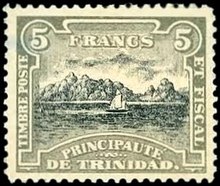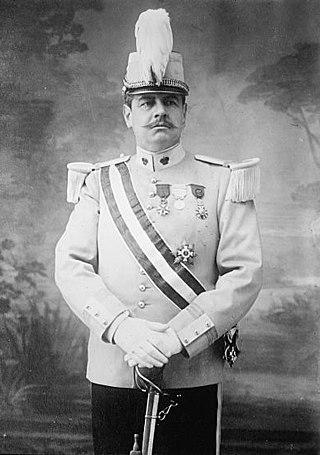
Louis II was Prince of Monaco from 26 June 1922 to 9 May 1949.

A self-proclaimed monarchy is established when a person claims a monarchy without any historical ties to a previous dynasty. In many cases, this would make them a pretender to the throne. The self-proclaimed monarch may be of an established state, such as Zog I of Albania, or of a micronation, such as Leonard Casley of Hutt River, Western Australia.

Prince Miguel Januário of Braganza was the Miguelist claimant to the throne of Portugal from 1866 to 1920. He used the title Duke of Braganza.

Prince Pierre of Monaco, Duke of Valentinois was the father of Rainier III of Monaco. He was a promoter of art, music, and literature in Monaco and served as the head of the country's delegation to the United Nations Educational, Scientific, and Cultural Organization (UNESCO) and to the International Olympic Committee.

Vitória is the capital of the state of Espírito Santo, Brazil. It is located on a small island within a bay where a number of rivers meet the sea. It was founded in 1551. The city proper is 93 square kilometres and has a population of 365,855 (2020), whilst the Greater Vitória metropolitan area has a population of more than 1,857,616 (2013), the 14th largest in Brazil.
Trindade is a town located on São Tomé Island, which is part of the island nation of São Tomé and Príncipe. Its population is 16,140. It is the seat of Mé-Zóchi District. It lies 7 km southwest of the capital São Tomé. Nearby places include Diogo Simão to the northeast, Lemos to the east, Cruzeiro to the south and Piedade to the west. There is a secondary school in Trindade, opened in 2011, with a capacity of 720 students.

Prince Philippe of Orléans, Count of Paris, was disputedly King of the French from 24 to 26 February 1848 as Louis Philippe II, although he was never officially proclaimed as such. He was the grandson of Louis Philippe I, King of the French. He was the Count of Paris as Orléanist claimant to the French throne from 1848 until his death. From 1883, when his cousin Henri, Count of Chambord died, he was often referred to by Orléanists as Philippe VII.

Prince Philippe, Duke of Orléans was the Orléanist pretender to the throne of France from 1894 to 1926 as Philippe VIII.
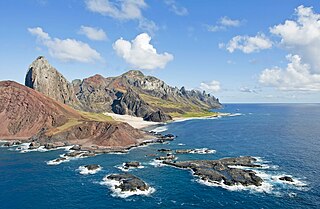
Trindade and Martim Vaz is an archipelago located in the South Atlantic Ocean about 1,100 kilometres east off the coast of the Brazilian state of Espírito Santo, of which it forms a part. The archipelago has a total area of 10.4 square kilometres and a navy-supported research station of up to 8 persons. The archipelago consists of five islands and several rocks and stacks; Trindade is the largest island, with an area of 10.1 square kilometres ; about 49 kilometres east of it are the tiny Martim Vaz islets, with a total area of 0.3 square kilometres.
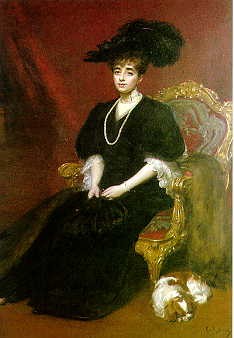
Anna Gould was an American socialite and heiress as a daughter of financier Jay Gould.

Edward Frederick Knight was an English barrister, soldier, journalist, and author of 20 books, many based on his dispatches as a war correspondent.

James Harden-Hickey was a Franco-American author, newspaper editor, duellist and adventurer. He was the founder of the self-proclaimed Principality of Trinidad, claiming title over the uninhabited island of Trindade in the South Atlantic Ocean.

Alexander, Prince of Lippe was the penultimate sovereign of the Principality of Lippe. Succeeding to the throne in 1895, Alexander had his power exercised by a regent throughout his reign on account of his mental illness.

The House of Orléans-Braganza is by legitimacy, the imperial house of Brazil formed in 1864, with the marriage of the heir to the Brazilian throne, Isabel of Braganza with Prince Gaston, Count of Eu. The House of Orléans-Braganza never reigned, as Brazil's pure Braganza monarch, Emperor Pedro II being deposed in a military coup d'état, under the pressure of the civilian republicans, in 1889. However, with the death of Isabel in 1921, as the last Brazilian pure Braganza, her descendants inherited the dynastic rights of the Brigantine dynasty over the defunct Brazilian throne.

This is a timeline of Amazon history, which dates back at least 11,000 years ago, when humans left indications of their presence in Caverna da Pedra Pintada.

There are 12 monarchies in the Americas, being either sovereign states or self-governing territories that have a monarch as head of state. Each is a constitutional monarchy, wherein the monarch inherits his or her office according to law, usually keeping it until death or abdication, and is bound by laws and customs in the exercise of their powers. Ten of these monarchies are part of the global personal union known as the Commonwealth realms and share Charles III, who resides primarily in the United Kingdom, as king. The other two are the Monarchy of the Netherlands which is used in states of the Dutch Caribbean, and the Monarchy of Denmark which is used in Greenland. As such, none of the monarchies in the Americas have a permanently residing monarch, though the Commonwealth realms each have a resident governor-general to represent King Charles III and perform most of his constitutional duties in his name; and a high commissioner represents the King of Denmark and the Danish government in Greenland. Additionally, each of Canada's 10 provinces functions as a subnational constituent monarchy, with the constitutional powers vested in the King exercised at the provincial level by a lieutenant governor.

This is a timeline of Brazilian history, comprising important legal and territorial changes and political events in Brazil and its predecessor states. To read about the background to these events, see History of Brazil.
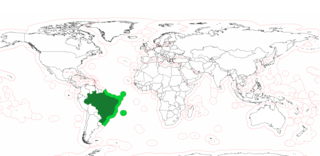
The Blue Amazon or Brazilian maritime territory is the exclusive economic zone (EEZ) of Brazil. It is an offshore area of 3.6 million square km on the Brazilian coast, rich in marine biodiversity and energy resources. The size is equivalent to the surface of the Amazon rainforest. The name is a reference to the biologically rich region of the Brazilian Amazon, with the addition of the adjective blue denoting the ocean.

